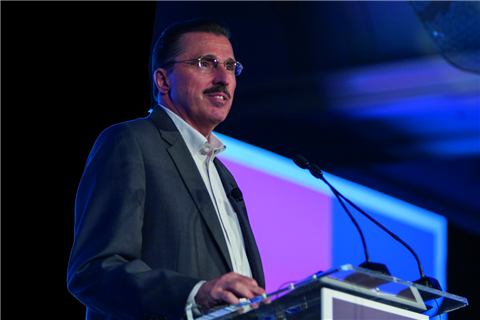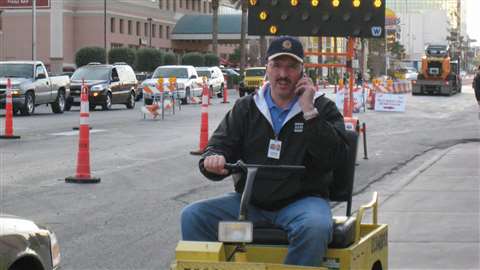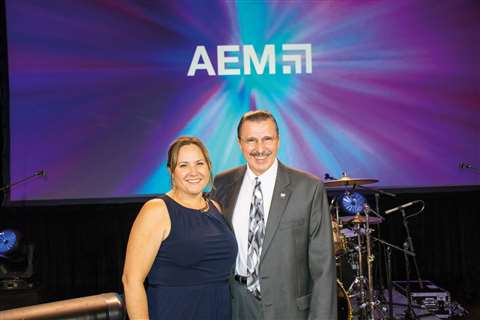Interview: AEM’s Dennis Slater reveals his post-retirement plans
11 January 2022
Retiring AEM President Dennis Slater looks back on remarkable career
The end of 2021 will mark the end of an era for the Association of Equipment Manufacturers (AEM). And the beginning of 2022 will see the beginning of a new one.
 After a 39-year career with AEM and its predecessor CIMA, AEM President Dennis Slater is retiring at the end of the year.
After a 39-year career with AEM and its predecessor CIMA, AEM President Dennis Slater is retiring at the end of the year.
On Dec. 31, AEM President Dennis J. Slater, the only president the association has had since it was formed in 2002, will retire. A day later, Slater will be succeeded by Megan Tanel, currently AEM senior vice president of the association’s Construction & Utility Sector.
Slater ends a 39-year career with AEM and its predecessor, the Construction Industry Manufacturer’s Association (CIMA). A journalism graduate from Carroll College in Waukesha, Wis., he began his career at CIMA in 1982 as a publications editor. He became president of CIMA in 1998 and oversaw the merger of CIMA and the Equipment Manufacturers Institute (EMI) into AEM in 2002.
Along the way he also served as director of ConExpo and chief operating officer and was instrumental in taking the association from one event (ConExpo) to multiple industry events including World of Asphalt, The Utility Expo, the combined ConExpo-Con/Agg co-located with IFPE, as well as overseas ConExpo events.
Under Slater’s leadership, AEM membership has grown by 50% to more than 1000 member companies and association revenues increased nearly 700% to $60 million annually.
In the first of two interviews by Diesel Progress and its KHL sister publication International Construction, Slater looks back on his time at the association. In an upcoming issue, incoming president Megan Tanel looks ahead.
When you got your BA in journalism, was association management something you ever anticipated becoming your life’s work?
Slater: It started pretty innocently. I got a job back in those days with CIMA, the Construction Industry Manufacturers Association, as the publications editor. So I still had that connection, doing news releases, newsletters, and kind of pitching stories. So at that point, I thought I was still part of the business.
Life made that turn, and I started running ConExpo and I left the writing side. But I always tell my son this, because he’s a journalist, too, I write more now and I communicate more now on my job than I ever did as a journalist.
So even though I had a short career doing that, my ability to communicate has really been my ticket to this position I have today. Although I never thought the association management world, I find that it’s nothing different as far as you have to tell your story and you have to be concise. And I still complain about writing in pyramid style and not burying your leads because our group is good at burying the lead. So it does help me a lot that way.
You were around during the tumultuous times between CIMA and EMA that resulted in some major companies skipping ConExpo. What are your primary memories of that time?
Slater: An interesting time. I think it was a good lesson also and it helped me later (realize) that good ideas might be before their time.
It did make sense to have one association representing manufacturers of equipment for construction, agriculture, but I don’t think the industry was ready. What happens is you have too many stakeholders on each side, and they want to control what happens.
 Slater was instrumental in the growth of ConExpo-Con/Agg into the premiere industry events in the world and he was a familiar presence before, during and after each event in Las Vegas.
Slater was instrumental in the growth of ConExpo-Con/Agg into the premiere industry events in the world and he was a familiar presence before, during and after each event in Las Vegas.
While it took 12 years to make it happen, the bad thing was ConExpo became a victim of that. People didn’t leave ConExpo because it wasn’t a good thing, they left it because this was part of a war. Today, that would seem normal, this is what we do with everything nowadays. But back then it was incredible. But I think what it did also showed that great opportunity, because in the end, I had the ability to run a ConExpo where you could change all the rules, you could open it up to everyone, make it a worldwide show.
People were open to changing the rules because of the fact that the main players weren’t coming back. So basically, I kind of made the long-term play to make it relevant again and keep it that way and to sooner or later get those big manufacturers back in. First you had ConExpo and Con/Agg coming together and then you have the merger being completed between CIMA and EMI. Then by 2000 everybody is happy again.
But that 1993 was critical. I remember a lot of the articles in the magazines were “will ConExpo exist anymore?” so it became my personal mission to make sure it did.
AEM runs a number of trade shows including one of the largest in the world. In the post (hopefully) pandemic world, what’s the role of tradeshows in the future?
Slater: I just got back from a conference of leading trade show organizers and we’re just all facing the same issue here. But I think in the end, I feel strongly about AEM’s future with ConExpo-Con/Agg.
I think there’s an importance of bringing customers and exhibitors together. That has to happen and there’s a need to do it in person. Now, I think it’s going to change – people aren’t going to have the same kind of time they had before. They’re a little less willing to travel like we did all these years. People have reset their clock. So you’ve got to find a formula where big, strong shows, those that have a great ROI and listen to the customer, they’re going to do well. And those will have to also address cost and make the attendees time valuable. Shows that just run on the same way, I think they’re going to have a short shelf life with that.
I think there’s a great future for trade shows that are going to be different. You’re going to have to have a virtual element to it that extends a show beyond its lifetime, beyond those five days. That’ll be tougher. And I think, in the short run, it’ll take time to build attendance back up. You’re going to see a lot of extra work being done by organizations that end with a smaller return in the beginning, but then that’ll build up again.
That’s the dilemma you face – you’ve built a business model on a certain return. And now you’ve got to do virtual, you’ve got to get more ROI, you’ve got to cut your costs and this will build up again.
I think it’s healthy for the industry. I think trade shows kind of got full of themselves for a long time and just kept charging all the time.
Would you say though, that one thing we’ve learned through the pandemic is the real value of face-to-face communication that trade shows bring?
Slater: I think it did. I went to a fly-in for us in September and everybody just wanted to be there again.
I was at the conference of trade show organizers and usually by the middle of the afternoon, people are dying to get home. They all stayed and it ended and people still didn’t want to leave.
I think there is a need to get together. And trade shows they’ve been doing that for 2000 years, probably, so that need of face to face will be there.
How effective do you think AEM has been in helping government understand the needs of the construction and agricultural industries?
Slater: Probably the biggest change since I’ve been here is the evolution of what you do for advocacy. When I started, we had an office in D.C., one person, and associations kind of reported on the news – here’s what’s going on.
About 10 years ago, this organization made a decision that we wanted to be influencers, we wanted to start influencing policy. So you go from one person in DC to 10 people there, most of them being lobbyists. You start to engage in issues, you start to do media tours, and, and fly-ins and congressional visits to tell your story, even when you’re not asking for the order.
In the end, what you’re doing is showing the importance of an industry and showing the importance of the jobs it brings. Then when you get to issues like infrastructure or the farm bill, they say, “Oh, yeah, that industry employs 2.8 million men and women, we’ve got to make sure we do things for them, we’ve got to make sure that we have a strong economy through them.” If anything, we’ve shown as an organization that we’re relevant in this.
If you go to any of our meetings, the one that always has everybody in attendance is our GPAC (Government & Public Affairs Committee). It’s with our directors and our member CEOs on and they all come to talk about it, that’s the area they engage. They know that that one bill could affect their earnings for the next year or two, so they’re engaged. So I think that’s an area where it’s a good success story for us.
What do you consider your most significant achievement in your time at AEM?
Slater: I think you have to say what were the difference makers? The merger that formed AEM, EMI and CIMA coming together to form this organization that represented a whole industry, because then you had this critical mass to go do things, and you can bring ambition with that.
And the other side of it is the formation of ConExpo and Con/Agg creating ConExpo-Con/Agg, because in the end, just like the merger did, it created the one powerhouse event that meant a lot to everybody.
The other part would be just kind of building the staff we built to do these things. The mergers of the show and of the organizations gave you the platform, then it was us getting very ambitious to go out there and do things with it. I think the biggest legacy is that part.
Are there any regrets about something you perhaps weren’t able to accomplish?
Slater: The funny thing is, there are no regrets. Really, everything’s kind of a work in progress.
In talking to my wife about doing this and retiring – and I’ve been planning this for a couple years – it was like, “Oh, yeah, but you have this one more thing to do.” But you always have one more thing to do. So in the end, I think the regret is a recognition that some things are a work in progress and even a lifetime of work doesn’t get to the finish line.
I look at AEM as I’ve taken it to a certain level, I think Megan and the team is going to take it to a higher level, which is really great. The regret is not being with those people when they do that next part.
How has AEM’s mission changed at all from when you started to now?
Slater: When you go way back, I think Dewayne Allen from Allen Engineering sent me a note about what we should do here. He just wrote it on a piece of paper and faxed it to me and it said, “help me sell my product – that should be your mission.”
 The present and the future: at the beginning of 2022, Megan Tanel will succeed Slater as president of AEM.
The present and the future: at the beginning of 2022, Megan Tanel will succeed Slater as president of AEM.
But I do think it’s gotten more sophisticated. So as we talk about advocacy and trade shows, this other area of market data has really emerged – where are the machines going? And later on, how efficient are these machines? If we can get into that part of it, if we can provide data and help the members do stuff there, I think that’s really going to be important.
So the mission is the same, helping you sell your product. But it’s also making sure people recognize that we are positive contributors to the economy, we’re not knocking down rain forests, like they told us in the ‘80s. We’re building the roads and bridges for the economy, we contribute to sustainability, we feed the world.
You want to be in the right side of those arguments and finally, this industry is. We’ve just got to talk about it a lot more
As you retire from the presidency of AEM, what will you miss most?
Slater: It can’t be the events, it’s the people really. I’ve had the pleasure, or even the honor to work with some really talented people. First of all, the staff we have here, very engaged, people that always want to improve. Every event I go to, they always tell me, “You guys got a great staff, you guys really go after it!” and it’s not a cliche. They mean, we have people that get things done.
But the other side is working with the executives at member companies, I’ve worked with some of the most talented people and got a first name basis with them. Or you get a guy like Ron DeFeo who calls you up and says, “Dennis, you got a minute?” Ron’s asking me if I have a minute? Jeez, it’s the other way around.
I think that part of being with all the talent in this industry, I think that’s the part I’ll miss the most.
What are you going to miss least?
Slater: I think it’s to watch where things just don’t get done. To watch an infrastructure bill, it just never seems to die. I swear to God, it’s like, rinse and repeat.
I would do annual stories on the economy and it would be like every year we’d talk about the same issues. I think also I won’t miss a Congress that just can’t do big things. They can’t do an interstate highway system like we did in the ‘50s. They just don’t think that way and you’ve got to think that sooner or later people look for the common good. But I don’t see that anytime soon and I couldn’t have put that many more years into waiting for that to happen. So that’s part I’ll miss the least.
How many air miles do you think you’ve put on over your years at AEM?
Slater: Ten years ago on American, I crossed two million miles. That’s funny because you know I’m from Milwaukee and that’s not even my primary carrier. The fact that it did a lot of my long hauls on American and now I’m at three million with them.
But at one time, I think between Midwest Airlines back in the day, American, Delta and United, I was in the premier club of all four. It’s not a badge of honor that you want. I always had the discussion when somebody asks my wife or my kids, “does your dad travel a lot?” And my son was like “well, what’s the definition of a lot?” If 150 days a year is the answer, then maybe it is.
I think you don’t come to that conclusion until you have a pandemic hit and suddenly you don’t do that. Then you’re like, how did I ever get any work done? Even though that was part of the job, how did I get any other stuff done because I was always on the road? And there were certain months, like it’d be September and the leaves are turning and all sudden it’s November, but you never saw the fall. You just came back and it was gone.
What are your plans for retirement?
Slater: The first thing is not to overcommit myself to getting into something. I’ve always learned the hard way that if I get involved in something, it’s like, “Wait! I’ve got some ideas how we can do this better!” and suddenly, I’m like running something again. So a key for me is to let things come to me and not go after them.
I think also to do the things I missed the last 39 years because I was busy doing this. I like to travel but maybe travel and see things and not meeting rooms. I’m a big history buff so I’m going to follow my passion with that. There are a couple of charities out there with literacy I want to get involved in. And of course, to spend more time with my family, especially my two granddaughters, to have some time to do that.
I know I’ll find things to keep me busy. I’m not ever going to be worried about the day where I’m like, “What am I gonna do next?” There’s so much to do.
It’s one of the reasons I decided that this was a good time. I’m healthy, I have time to do things – let’s get out there and do some of that.
STAY CONNECTED



Receive the information you need when you need it through our world-leading magazines, newsletters and daily briefings.
CONNECT WITH THE TEAM







